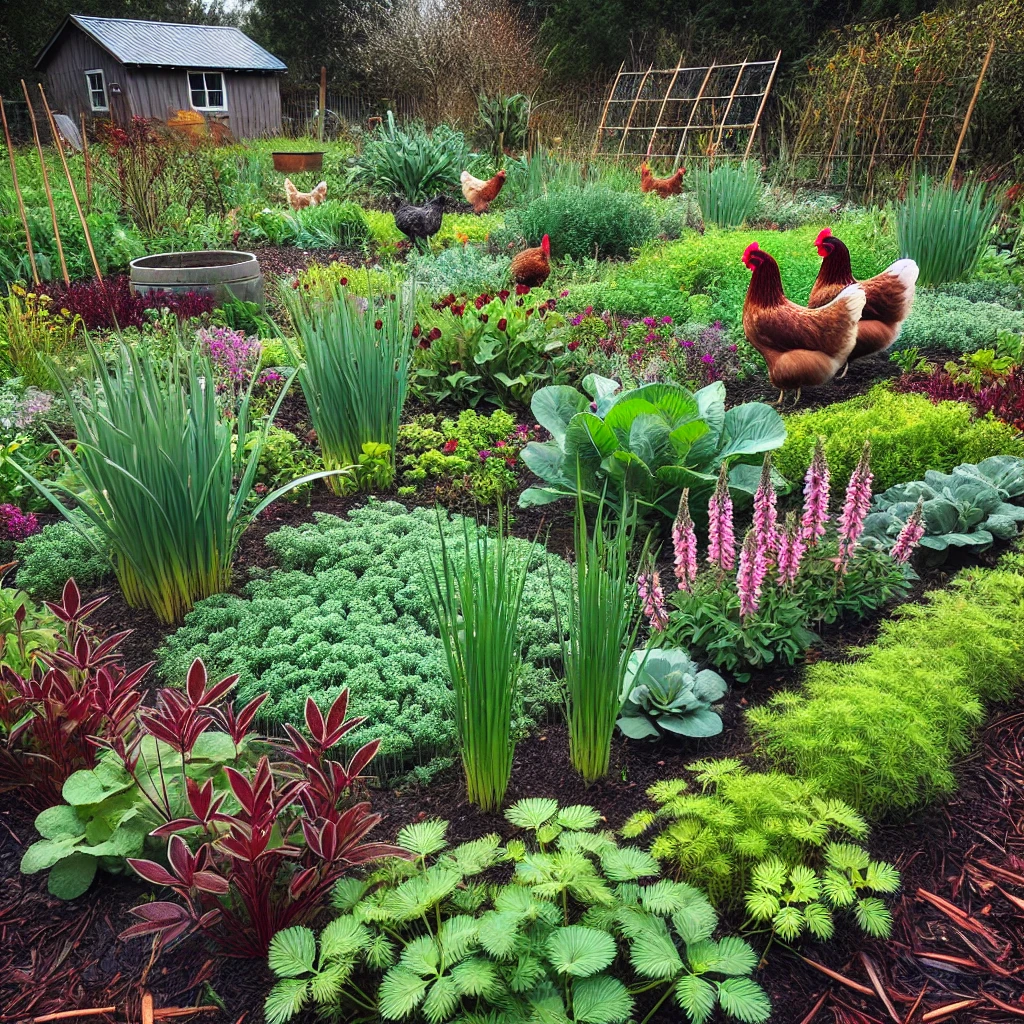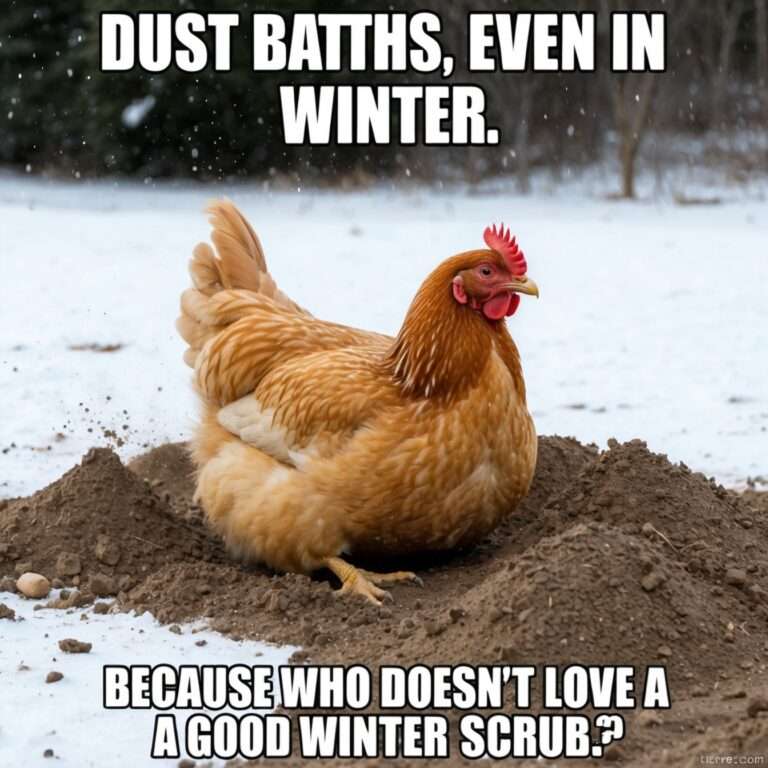
How to plant winter cover crops in Southeastern gardens for soil health and chicken forage.
Winter Cover Crops for Chickens are an excellent way to improve soil health, reduce erosion, suppress weeds, and provide forage for free-range chickens. In the Southeastern U.S., where mild winters and nutrient-depleted soils are common, these crops bring seasonal benefits that enhance long-term soil quality and sustainable chicken grazing. This guide will show you how to plant winter cover crops for chickens and create a thriving, resilient garden that supports both your soil and your flock.
1. Choosing the Right Winter Cover Crops for Chickens
The first step to success is selecting crops that thrive in Southeastern winters. These crops should tolerate cool weather, grow quickly, and offer dual benefits for soil health and chicken forage. Here are some of the best options:
- Winter Rye: A fast-growing grass that prevents erosion and suppresses weeds.
- Crimson Clover: A nitrogen-fixing legume that enriches the soil and provides early spring blooms.
- Winter Wheat: Hardy and versatile, stabilizing soil while adding organic matter.
- Austrian Winter Peas: Fixes nitrogen and provides high-protein forage for chickens.
- Daikon Radish: Known as a “tillage radish,” it aerates compacted soil with its deep roots.
Why These Work:
Each of these crops brings unique benefits. Winter rye and wheat create a dense ground cover, clover and peas add nitrogen, and daikon radishes break up compacted soil, improving water and nutrient penetration for spring planting.
2. Planning for Soil Improvement and Chicken Forage
Combining cover crops is key to maximizing benefits for both soil health and chicken forage. A mix of crops ensures varied root depths and growth habits, which improve soil at multiple levels while offering diverse forage options.
Ideal Combinations:
- Winter Rye + Crimson Clover + Daikon Radish: Combines erosion control, nitrogen fixation, and soil aeration.
- Winter Wheat + Austrian Winter Peas: Balances soil stabilization with high-quality greens for chickens.
Tip: Always include legumes like clover or peas in your mix for nitrogen fixation. These crops pull nitrogen from the air and release it into the soil, boosting fertility for future plantings.
3. Broadcasting and Seeding Techniques
Broadcasting seeds is a simple and effective way to plant large areas with winter cover crops. Mixing seeds ensures even distribution, and each crop will naturally find its preferred growth zone.
How to Broadcast:
- Prepare the soil by clearing debris and lightly tilling the surface.
- Mix seeds in a bucket and scatter them evenly across the area.
- Rake the soil lightly to cover seeds, aiming for a depth of ¼ to ½ inch.
Adjusting Seeding Rates:
When planting a mix, reduce each crop’s seeding rate by 20–25% to avoid overcrowding. This allows each plant to thrive without competing for resources.
4. Protecting Young Cover Crops from Chickens
Chickens are naturally curious and may disturb seeds or young seedlings. To ensure successful germination, take steps to protect your cover crops.
Protection Strategies:
- Straw Mulch: A light layer of straw deters chickens while allowing sunlight and water to reach the seeds.
- Temporary Fencing: Low garden netting can restrict access to planted areas until crops are established.
Once the cover crops mature, they can handle light grazing without damage.
5. Timing and Rotation for Sustainable Soil Health
Timing is critical for successful winter cover crops. In the Southeast, planting in early November gives crops time to establish before winter temperatures drop.
Key Steps:
- Plant in Early November: Ensure crops have time to sprout and grow before the coldest weather.
- Till or Mow Down in Early Spring: Cut the cover crops down and till them into the soil at least two weeks before planting spring crops. This allows organic matter to decompose and enrich the soil.
Self-Reseeding Options:
Some crops, like crimson clover, may reseed naturally if allowed to bloom. This creates a low-maintenance, self-sustaining ground cover for your garden.
6. Managing Chicken Access for Optimal Foraging and Growth
Chickens enjoy foraging on fresh greens like ryegrass, clover, and peas, but overgrazing can damage your cover crops. Rotational grazing allows plants to recover between foraging sessions, maintaining a healthy balance.
Rotational Grazing Tips:
- Divide your garden into zones and rotate chicken access to different areas.
- Allow one section to regrow while another is being grazed.
- Monitor grazing intensity, especially with crops like mustard greens, which can upset chickens’ digestion if overconsumed.
7. Benefits of Winter Cover Crops for Spring Gardening
Winter cover crops prepare your garden for spring planting by improving soil structure, increasing organic matter, and naturally fertilizing the soil with nitrogen.
Key Benefits:
- Improved Soil Health: Nitrogen-fixing legumes provide a natural fertilizer, reducing the need for synthetic inputs.
- Weed Suppression: Dense cover crops shade out weeds, reducing competition for soil nutrients.
- Organic Matter: As cover crops decompose, they enrich the soil with nutrients, creating ideal conditions for nutrient-demanding crops like tomatoes, corn, and squash.
Conclusion
Planting winter cover crops for chickens in Southeastern gardens is an effective way to boost soil health and provide forage for your flock. By choosing the right crops, protecting young plants, and managing grazing, you can create a self-sustaining garden that supports both your soil and your chickens. With a little planning, your winter garden can reduce the need for spring fertilization and ensure a thriving ecosystem year-round.
Further Reading on Paranoid Prophet
- Winter Chicken Memes and Facts: Dive deeper into the lighter side of chicken care with a collection of winter-themed chicken memes and fun facts about how chickens handle the cold. You’ll discover amusing insights and practical tips for your feathered friends in winter.
- Poultry Care & Backyard Flocks: Explore the full range of poultry care content, where you’ll find articles on optimizing your backyard flock’s health, well-being, and happiness. Whether you’re new to raising chickens or a seasoned keeper, this section provides valuable advice for every aspect of chicken ownership.
- Wheatgrass Hay & Winter Chickens: Learn about the benefits of wheatgrass hay for your chickens during the winter months. This article explores how adding wheatgrass to their diet can enhance your flock’s nutrition and overall health, helping them thrive through colder seasons.
Sources
Planting winter cover crops in the Southeastern U.S. offers numerous benefits, including soil enrichment, erosion control, weed suppression, and providing forage for free-range chickens. The following resources offer valuable insights into selecting and managing appropriate cover crops for this region:
- Winter Annual Cover Crops – NC State Extension Publications
This publication discusses the use of winter annual cover crops in the Southeast, highlighting species like cereal rye, crimson clover, and Austrian winter peas. It provides guidance on planting dates, seeding rates, and the benefits of each crop in terms of soil health and erosion control. - Managing Forage for Free-Range Chickens – Cackle Hatchery
This article explores various forage options for free-range chickens, including the use of cover crops such as spelt, which serves as a winter cover crop providing early spring greens. It emphasizes the importance of nutritious forage in maintaining healthy poultry. - Winter Cover Crops for North Carolina | NC State Extension
This resource lists suitable winter cover crops for North Carolina, including legumes like crimson clover and Austrian winter pea, and non-legumes such as cereal rye and barley. It offers insights into the benefits of each crop and considerations for their use in sustainable farming practices. - Best Cover Crops For Chickens – Gardening Know How
This article discusses the advantages of growing cover crops for chicken feed, such as buckwheat and cowpea. It explains how allowing chickens to forage on these crops can enhance their health and contribute to natural soil fertilization through their manure.
These resources provide comprehensive information on selecting and managing winter cover crops in the Southeastern U.S., benefiting both soil health and free-range chicken foraging.
FAQ: Winter Cover Crops for Chickens
Understanding Winter Cover Crops
1. What are winter cover crops, and why are they beneficial for chickens?
Winter cover crops are plants grown in cooler months to protect and improve soil. They benefit soil health, suppress weeds, reduce erosion, and offer supplemental forage for free-range chickens.
2. How do winter cover crops improve soil health?
They enhance soil by adding organic matter, fixing nitrogen (with legumes like clover), and aerating compacted ground (with crops like daikon radish). This creates fertile, nutrient-rich soil for spring planting.
3. Are winter cover crops suitable for all climates?
While particularly effective in the Southeastern U.S. due to mild winters, winter cover crops can be adapted to various climates by choosing cold-hardy species like winter rye and wheat.
Best Crops for Chickens and Soil
4. What are the best winter cover crops for chickens in the Southeast?
The best options include:
- Winter Rye: Erosion control and weed suppression.
- Crimson Clover: Nitrogen-fixing and forage.
- Austrian Winter Peas: High-protein forage and nitrogen-fixing.
- Daikon Radish: Soil aeration with deep roots.
- Winter Wheat: Organic matter and soil stabilization.
5. Can I use a mix of cover crops?
Yes, mixing crops like rye, clover, and radish provides multiple benefits: erosion control, nitrogen enrichment, and diverse forage for chickens.
6. Do chickens have a preference for certain cover crops?
Chickens prefer tender greens like ryegrass, clover, and peas. Mustard greens can also be used sparingly but may upset digestion if consumed in large amounts.
Planting and Timing
7. When should I plant winter cover crops for chickens?
Plant them in early November to allow establishment before the coldest months. By spring, they’ll be ready for tilling or grazing.
8. How do I plant winter cover crops?
Broadcast seeds across prepared soil, rake lightly to cover them, and aim for a planting depth of ¼ to ½ inch.
9. Can I let cover crops reseed naturally?
Yes, some crops like crimson clover will self-reseed if allowed to bloom, reducing maintenance for future seasons.
Protecting and Managing Crops
10. How do I protect cover crops from chickens?
Use straw mulch or temporary fencing to shield seeds and seedlings from scratching until plants are established.
11. How can I prevent overgrazing by chickens?
Divide the planting area into zones and rotate chicken access to allow crops time to recover and regrow.
12. Are cover crops safe for free-range chickens?
Yes, most cover crops are safe and nutritious. However, avoid overfeeding certain plants like mustard greens, which can cause digestive upset.
Seasonal and Long-Term Benefits
13. What are the long-term benefits of winter cover crops?
They enhance soil structure, add organic matter, reduce weeds, and naturally fertilize the soil with nitrogen, cutting down on the need for synthetic fertilizers in spring.
14. How do I manage cover crops in spring?
Mow or till the cover crops into the soil two weeks before planting. This allows organic material to decompose, enriching the soil with nutrients.
15. Can cover crops replace chicken feed?
No, cover crops are a supplemental forage source. They enhance the diet of free-range chickens but do not replace the balanced nutrition provided by commercial poultry feed.


